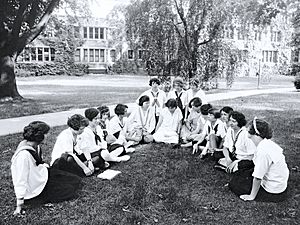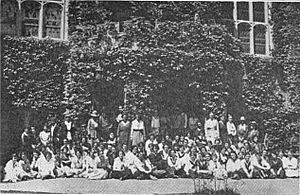Bryn Mawr Summer School for Women Workers in Industry facts for kids
The Bryn Mawr Summer School for Women Workers in Industry was a special summer program. It ran from 1921 to 1938. Each year, about 100 young working women came to the Bryn Mawr College campus. This college is in Bryn Mawr, Pennsylvania. Most of these women were factory workers with little schooling. They spent eight weeks studying subjects like history, literature, and economics.
This program was part of a bigger movement in the 1920s and 30s to educate workers. It was very special for a few reasons. It was the first program of its kind for women in the United States. Women created, led, and mostly taught the classes. Also, a women's college hosted it.
M. Carey Thomas, the president of Bryn Mawr College, first thought of the idea. Rich people like John D. Rockefeller Jr. helped pay for it. Teachers came from well-known local schools. Under the leadership of Hilda Worthington Smith, the program became very successful. It even became a model for other similar schools. Many students came from different backgrounds and worked in various jobs. A lot of them later became important leaders in labor unions. The college's leaders eventually stopped supporting the program for political reasons. It closed in 1938.
The school is also the topic of a 1985 movie called The Women of Summer. This documentary was made by Suzanne Bauman and Rita Heller.
Contents
History of the School
How the School Started
M. Carey Thomas, the president of Bryn Mawr College, got the idea for the school after visiting similar programs in England. These were run by the Workers' Educational Association (WEA). Thomas said she had a vision in 1919 while traveling. She imagined a world where working people had fair opportunities. She also saw that women could help each other achieve this goal.
In late 1920, Thomas talked with Dean Hilda Worthington Smith and Professor Susan M. Kingsbury. They discussed starting a summer school for working women. Important labor leaders also joined the planning committee. These included Mary Anderson from the U.S. Women's Bureau. Fannia Cohn from the International Ladies' Garment Workers' Union also helped. Rose Schneiderman from the Women's Trade Union League was another key member.
The school's goal was clear. A 1929 pamphlet said it aimed to help young women in industry. It wanted to give them chances to study different subjects. It also wanted to help them think clearly. The school hoped to make them interested in economic problems. It also wanted them to enjoy learning for life. The school did not support any single political idea. It hoped students would better understand industry problems. It also wanted them to feel responsible for finding solutions.
The school welcomed its first 82 students on June 15, 1921. To join, students had to be between 20 and 35 years old. They needed to have worked for at least three years, with two years in industry. They also needed at least a sixth-grade education. Students had to be able to read and write English. They also had to work with tools, not as managers or office workers.
How the School Was Run
Hilda Worthington Smith led the summer school for thirteen years. She is given credit for making it a very successful program. A group called the Joint Administrative Committee managed the school. This committee had an equal number of women from industry and women from Bryn Mawr College. For example, Rose Schneiderman served on this committee for three years.
The School Council met once a week to plan activities. It included seven students, three administrators, and three teachers. Local committees also helped. They had equal numbers of industry women and Bryn Mawr women. These committees found students and raised money. Many different people and groups provided funding. This included John D. Rockefeller Jr. and the Amalgamated Clothing Workers of America union.
About 90 teachers worked at the school between 1921 and 1938. These included both union leaders and well-known university professors. Most of the teachers were women.
Learning and Classes
M. Carey Thomas and Hilda Worthington Smith based their teaching ideas on the WEA programs. They also used the educational ideas of John Dewey. They believed in bringing together many different kinds of people. This included union leaders and wealthy Bryn Mawr graduates. Mill workers who left school at 12 learned alongside university professors. Union and non-union workers from all over the U.S. attended. Immigrants from Russia, Italy, and Eastern Europe studied with native-born Americans. Protestants, Catholics, and Jews learned together.
One student told the Woman's Journal that they were "learning toleration." Another student said that mixing with people from many industries and places helped her. She realized that "the problem of each working woman was the problem of all."
At first, the study program was very big. Workers with little schooling felt overwhelmed. Over time, students gave their ideas, and the classes changed. They became more focused on what the students needed. By 1928, they used the "Unit Method." Classes were divided into groups of about 20 students. Each group had two full-time professors. One taught English, and the other taught economics. A 1929 pamphlet described the teaching plan. It mentioned "Small classes in Economics, English Literature, Composition, Public Speaking, Science and Psychology." It also noted a "tutoring system" to help workers learn a lot in two months.
There were no grades or exams. Students received a certificate for attending at the end of the summer. Since they were adults, students were encouraged to help make decisions. They also helped plan activities and join class discussions. Teachers made sure to learn about each student's background and needs.
Besides regular classes, students heard talks from many famous guest speakers. These included John Dewey, W.E.B. Du Bois, Eleanor Roosevelt, and Frances Perkins. They also went on field trips to museums, historical places, and factories. Students could take tennis and swimming lessons. They held a yearly folk music festival. It featured music from the students' home countries. They also published a student magazine called Shop and School. It had stories, poems, jokes, and plays. When John Dewey visited the school in 1931, he called it a "model of progressive education."
Including All Races
In 1926, students suggested that the school admit African-American students. Hilda Worthington Smith agreed and welcomed the first five Black students. This was a big decision. Bryn Mawr College itself had never admitted a Black student before. M. Carey Thomas warned Smith not to "complicate" things. She quoted her friend Susan B. Anthony, saying, "Do not mix reforms." But Smith continued to admit Black students despite Thomas's concerns.
The Final Years
From the very first year, the working women at Bryn Mawr were very active. In 1921, they organized a student protest. They demanded better working conditions for the college's Black maids and groundskeepers. In the 1930s, the Great Depression made things harder. There were more tensions between the politically active students and Bryn Mawr's rich donors and leaders. One leader asked, "Why should we support your organizing workers to strike our husbands' plants?"
In 1934, students and teachers visited a nearby food-packing plant. They went to observe a strike by farm workers. The Philadelphia Inquirer newspaper reported that Bryn Mawr was involved in the strike. The college leaders were worried by the news. They closed the summer school for a year. It reopened in 1936, but the damage was done. Funding became less and less. The Bryn Mawr Summer School for Women Workers in Industry closed for good in 1938.
Lasting Impact
Historian Rita Heller studied the students in 1982. She found that some students felt unsure about how useful the program was. But most said it helped them feel better about themselves. It also improved their social skills. They believed the school helped them get ahead in their jobs. Many students became leaders in their communities, churches, and labor unions. For example, Elizabeth Nord became a leader in the New England Silk and Rayon Workers Union. Carmen Lucia became a vice president of the United Hatters, Cap and Millinery Workers International Union. Rose Finkelstein Norwood led the Boston chapter of the Women's Trade Union League.
The Bryn Mawr school became a model for several other worker education programs. These included the Wisconsin Summer School and the Barnard Summer School. Others were the Vineyard Shore School and the Southern Summer School. The coeducational Hudson Shore Labor School also followed its example.
Former students and teachers of the summer school had a reunion at Bryn Mawr in June 1984. Several women from this reunion were in the 1985 documentary, The Women of Summer. This film was a team effort by filmmaker Suzanne Bauman and historian Rita Heller. The National Endowment for the Humanities helped fund the movie. It won several awards, including the Red Ribbon from the American Film Festival. It also won the CINE Golden Eagle.
Notable Teachers
The following well-known people taught at the summer school:
- Elizabeth Brandeis, economist
- Millicent Carey, educator
- Alice Hanson Cook, scholar
- Grace Coyle, sociologist
- Mary Florence Curran, artist and social reformer
- Ida Craven, economist
- Marion Dickerman, educator
- Paul Douglas, politician and economist
- Eleanor Lansing Dulles, economist, author
- Edward M. Earle, historian
- Genevieve Fox, author
- Winifred Frost, biologist
- Alice Henry, labor leader
- Lillian Herstein, labor leader
- Amy Hewes, sociologist and economist
- Leo Huberman, writer
- Hazel Kyrk, economist
- Mildred H. McAfee, educator
- Broadus Mitchell, historian
- Helen Muchnic, scholar
- Gladys Palmer, economist
- Esther Peterson, consumer and women's advocate
- Katherine Pollak Ellickson, labor economist
- Mark Starr, labor historian
- Mary van Kleeck, scholar of women's labor
- Caroline F. Ware, historian and activist
- Colston Warne, economist and consumer advocate
- Theresa Wolfson, labor economist



